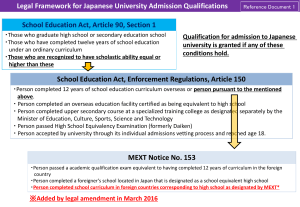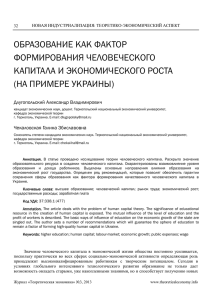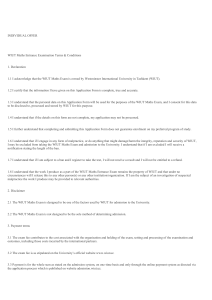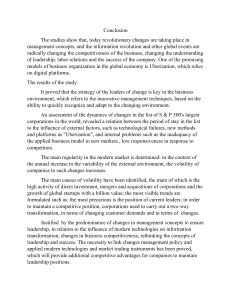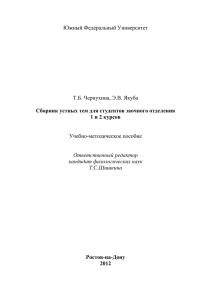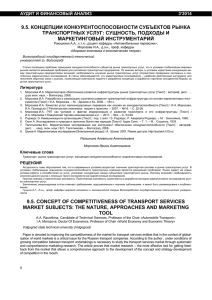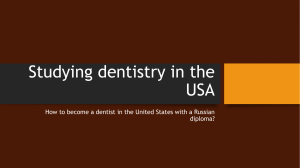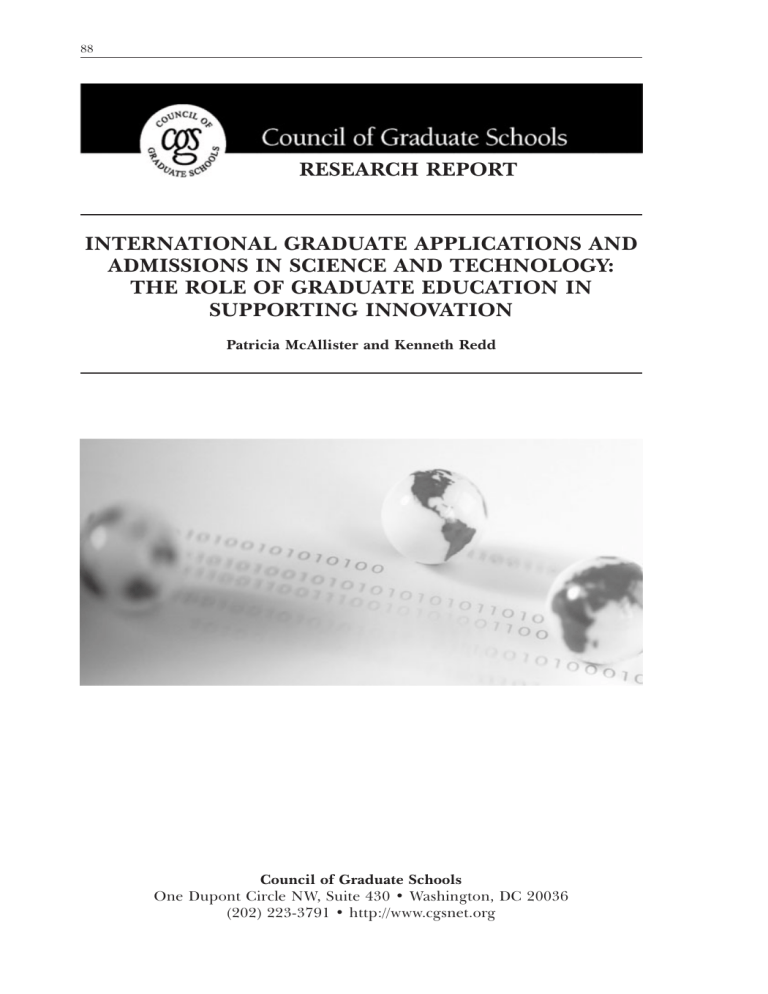
88 RESEARCH REPORT INTERNATIONAL GRADUATE APPLICATIONS AND ADMISSIONS IN SCIENCE AND TECHNOLOGY: THE ROLE OF GRADUATE EDUCATION IN SUPPORTING INNOVATION Patricia McAllister and Kenneth Redd Council of Graduate Schools One Dupont Circle NW, Suite 430 • Washington, DC 20036 (202) 223-3791 • http://www.cgsnet.org 89 OVERVIEW Every year since 2004, the Council of Graduate Schools (CGS) has undertaken an extensive, multi-year empirical examination of international graduate application, admission, and enrollment trends. This analysis responds to member institutions’ concerns about continuing changes in the enrollment of students from abroad seeking master’s and doctoral degrees from American colleges and universities. The analysis also responds to concerns about international student trends in enrollments in science, engineering, and technology programs at American graduate schools. The core of this examination is a three-phase survey of CGS member institutions. The survey collects an initial snapshot of graduate school applications (Phase I, conducted in February of each year), final applications and an initial picture of admissions offers (Phase II, June), and final offers of admission, first-time enrollments, and total enrollments (Phase III, October). The 2004 Phase II report found a 28% decrease in international applications and an 18% decline in initial admissions offers.1 In 2005, applications fell by 5%, but admissions offers grew 3%.2 Last year’s Phase II report revealed a 12% increase in both final applications and initial offers of admission.3 CGS survey data for 2007 suggest that American graduate schools have continued to attract an increasing number of applications from prospective international students, and offers of admission also continue to rise—particularly for prospective students in science and engineering fields. But the overall rates of increase in both applications and offers of admission to prospective new students from overseas slowed between 2006 and 2007. Moreover, the rebound in international applications still has not been large enough to reverse the declines that were reported in the initial Phase II study. This survey report also, for the first time, documents the percentage of American graduate schools that have established science, engineering, and other graduate degree programs with international colleges and universities. This report first describes the survey methodology used to collect and calculate the changes in applications and admissions data for 2007, and then compares the more recent trends with those from prior years. The third section examines the prevalence of “collaborative” degree programs between American graduate schools and international universities. A related report released by CGS in April 2007 reviewed the best practices in graduate education in a variety of fields including science, technology, engineering, and mathematics (STEM). The report “Graduate Education: The Backbone of American Competitiveness and Innovation” espoused five key assumptions to undergird a policy network associated with critical issues related to enhancing U.S. competitiveness and innovation. The proposed policy recommendations intended to enhance innovation include: continuing to attract and retain the best and brightest students from around the world; and expanding the participation of domestic students, particularly those from underrepresented racial/ethnic minority groups into fields that are essential to America’s success. 90 The second part of this paper provides an overview of the April report, including recommendations and policy proposals to address and increase enrollments of international and domestic students in STEM fields. THE 2007 INTERNATIONAL GRADUATE ADMISSIONS PHASE II: FINAL APPLICATIONS AND INITIAL OFFERS OF ADMISSION SURVEY REPORT Survey Methodology and Response Rate The 2007 International Graduate Admissions Phase II: Final Applications and Initial Offers of Admission survey was sent to 473 American colleges and universities that were members of CGS as of June 2007.4 The survey asked these institutions to report the total number of international students who applied for and were offered admission to master’s and doctoral degree programs, the number of applications and admissions offers to students who originate from four key international countries or regions, and the number of applications and admissions offers in seven key fields of study. CGS defines an international student as a person who is not a citizen, national, or permanent resident of the United States and is in this country on a student visa, or on a temporary basis, and does not have the legal right to remain indefinitely.5 Roughly 34% (160) of the survey population provided usable responses as of the date this analysis began. The response rates among certain types of institutions were even higher: nine of the ten institutions with the largest international graduate student enrollment, 84% of the largest 25, and 68% of the largest 50 provided usable survey responses.6 The high participation rate among the campuses with the largest international enrollment is important because collectively the 50 largest institutions enroll more than 41% of the total international graduate student population.7 The high response rate among these institutions suggests that the survey results accurately depict recent trends in applications and admissions offers in U.S. graduate schools. The Phase II survey asked institutions to provide their final number of applications received for admission to graduate programs for fall 2006 and fall 2007 and the number of applications accepted for admission in the same period. For some campuses, the CGS survey was administered before the final total number of admissions offers to international graduate students was known. For that reason, the survey results for admissions offers (described in the next section of this report) should be considered an initial snapshot. The Phase III survey will provide an update of the admissions offers, as well as changes in first-time and total enrollment of international graduate students. Survey Results Overall Applications and Admissions Offers After a sharp decline in 2004 and small rebound in 2005, the total number of prospective international students who applied for admission to master’s and doctoral programs at American graduate schools rose solidly between 2006 and 2007. 91 Table 1. Change in Applications and Offers of Admission, 2006 to 2007 Total International Phase I Survey: (March) Initial Change in Applications 2006 to 2007 Phase II Survey: ( June) Final Change in Applications 2006 to 2007 Phase II Survey: ( June) Initial Change in Offers of Admission 2006 to 2007 8% 9% 8% 17% 6% -2% 9% 19% 12% 0% 17% 24% 17% -2% 12% 7% 8% 8% 12% 13% 8% 0% 15% 12% 13% 8% 18% 12% 0% 10% 11% 16% 10% 11% 8% 4% Country of Origin China India South Korea Middle East* Field of Study Business Education Engineering Humanities & Arts Life Sciences Physical Sciences Social Sciences Source: 2007 CGS International Graduate Admissions Survey II: Final Applications and Initial Offers of Admission, August, 2007. *Middle East: Bahrain, Cyprus, Iran, Iraq, Israel, Jordan, Kuwait, Lebanon, Oman, Palestinian Authority, Qatar, Saudi Arabia, Syria, Turkey, United Arab Emirates, Yemen. As Table 1 shows, the overall number of international applications rose by 9% from 2006 to 2007. This year’s increase is on top of the 12% gain reported in 2006 (see the Overview section of this report). Despite the sharp increases in the two most recent surveys, international applications are still below their 2003 levels at many schools. About 78% of the institutions that responded to the Phase II survey in both 2004 and 2007 reported that the number of international graduate admissions applications received by these institutions in 2007 was 19% lower than it was in 2003. Initial offers of admission to prospective international graduate students in 2007 rose 8%, nearly equal to the increase in applications. However, similar to applications, even this growth has not made up for earlier declines; among the institutions that responded to the Phase II survey in 2004 and 2007, offers of admission to international students are still down by 1%. Applications and Admissions Offers by Country of Origin India, China, and South Korea rank as the top three countries of origin for international students in the United States. Collectively, students from these three nations accounted for about one-half of all non-U.S. students attending American graduate schools in 2006, according to research from both CGS and the Institute of International Education.8 Students from these three nations also account for a large share of the international students enrolled in STEM disciplines. Thus, examining student flows from these three countries provides a good indicator of overall international student trends and trends in science, engineering, and technology fields. Applications from and admissions offers to prospective students from countries in the Middle East9 have also been included in the CGS surveys because of the 92 geopolitical importance of this region; graduate students from this region account for about 5% of total international enrollment. In 2007, the total number of international graduate applications from China and India increased by 19% and 12%, respectively, while applications from the Middle East rose 17%. In contrast, applications from South Korea were flat. The initial change in admissions offers follows the same pattern as applications. The number of admissions from Korea fell 2% in 2007. Admissions offers to prospective students from China, on the other hand, jumped 24%, offers to applicants from India increased 17%, and admissions offers to those from the Middle East gained 12%. Applications and Admissions Offers by Fields of Study The fields of engineering, physical sciences, and life sciences currently account for about 53% of international students engaged in graduate education in the United States, based on responses to the most recent CGS Graduate Enrollment and Degrees survey report.10 Two of these fields of study had double-digit growth in applications and admission offers in 2007, as Table 1 demonstrates. Engineering had a 13% increase in international graduate applications in 2007 and a 16% rise in admissions offers, and life sciences had increases of 18% and 11%, in applications and offers, respectively. In physical sciences, applications grew 12%, but the offers of admissions gained only 8%. The results for other (non-science and technology) fields were mixed. In social sciences, applications were flat and admissions offers gained just 4%, while education saw a 12% gain in applications and an 11% increase in admissions offers. Business experienced a 15% increase in international student applications and a 10% gain in offers of admissions. Humanities & arts reported an increase in applications of 8% and a rise in admissions offers of 10%. COLLABORATIVE DEGREE PROGRAMS Colleges and universities across the globe have partnered on various educational programs for many years, particularly in the development of collaborative degree and certificate programs.11 These programs go by a variety of names, and it is important to note that there is no single, standard definition for them. However, they do share some common characteristics, such as: • they are developed by two or more institutions in each of the participating countries; • the curricula are developed and approved by faculty and administrators at each participating higher education institution; and, • the participating institutions collaborate on student admissions and selection criteria.12 The majority of collaborative degree programs allow students to receive a dual or double degree, under which students take courses and receive a degree, diploma, or certificate from each participating college or university. Some programs use a 93 joint degree structure, through which students take courses at each participating college or university, but commonly they receive only one degree, diploma, or certificate from their college or university of registration. The student’s award may either be in the names of both participating institutions, or the student’s transcript may indicate that he or she participated in a collaborative degree program.13 Unfortunately, very little empirical information exists abut the number and types of international collaborative degree arrangements being made between U.S. and international colleges and universities. In order to document the prevalence of collaborative degree programs between American graduate schools and international colleges and universities, CGS’s Phase II survey, for the first time, asked graduate deans to report on the types of collaborative degree programs their institutions have developed and the fields of study in which these programs have been developed. Two recent developments have triggered the need to collect and analyze information about the establishment of dual, joint, and other collaborative programs between American graduate schools and international colleges and universities. First, increased competition for international students, both among American institutions and between American and international universities, may be giving U.S. graduate school deans an incentive to design attractive collaborative degree programs that will attract students both from America and abroad. Second, improvements in technology and communications may be making it easier for institutions to share resources that make collaborative degree programs possible; improvements in Web-based teaching technology, for instance, may make it feasible for faculty to develop and teach courses to students far beyond their countries’ borders. As this is the first time CGS has collected information on collaborative degree programs, this survey data serves as a baseline upon which discussions of these issues may be further examined. Future surveys may build on this baseline and allow CGS to analyze trends in the development of these programs by U.S. graduate schools. Prevalence of International Collaborative Degree Programs The CGS survey asked institutions to indicate which types of collaborative degree programs they currently have with international higher education institutions. As Table 2 on the next page indicates, 11% of all respondents have established one dual/double degree program, and 7% have initiated a joint degree program. A smaller share of all respondents (about 3%) said they have established one or more programs that award both dual and joint degrees, while just 1% had programs that award a dual degree and some other type of collaborative degree or certificate. Dual/double degree programs are the most common type of collaborative arrangement, particularly at colleges and universities that enroll large numbers of international students. About 44% of the respondents from the ten largest American colleges and universities (in terms of numbers of international students) have established a dual/double international collaborative program. In contrast, none of the largest ten institutions have a joint program and 11% have some “other” type of program. 94 Table 2. Percentage of American Graduate Schools That Have Established Graduate Degree Programs With One or More International Higher Education Institutions, by International Graduate Student Enrollment Size and Degree Program Type International Graduate Enrollment Size14 Degree Program Types Dual/Double degree program only Joint degree program only Other type of degree program only Dual & Joint degree programs Dual & Other degree programs Total With One or More Collaborative Program(s) No Programs No Response Largest 10 Largest 25 Largest 50 All Other Institutions Total (All Respondents) 44% 0% 11% 0% 0% 56% 44% 0% 33% 5% 5% 5% 0% 48% 33% 19% 32% 3% 12% 9% 0% 56% 32% 12% 5% 8% 6% 2% 1% 22% 61% 17% 11% 7% 7% 3% 1% 29% 55% 16% Source: 2007 CGS International Graduate Admissions Survey II: Final Applications and Initial Offers of Admission, August 2007. Due to rounding, percentages may not total to 100. In total, Table 2 indicates that about 29% of American graduate schools have established at least one type of collaborative graduate degree program with another international college or university. However, even higher shares of the institutions that enroll the largest number of international students have established such programs. Roughly 56% of the survey respondents from the largest ten institutions, 48% of the largest 25, and 56% of the largest 50 colleges and universities said they have at least one collaborative degree program, compared with only 22% of the institutions with enrollments below the largest 50. It should not be a surprise that larger institutions are more likely than smaller ones to have established collaborative degree programs, as larger institutions have more international students and thus may have greater interest in collaborating with colleges and universities outside the U.S. However, as technology is further enhanced and best practices emerge, it is likely that more institutions with smaller enrollments will establish international collaborative degree programs in the future. Collaborative Degree Programs in Science and Technology Table 3 on the next page shows the fields of study in which survey respondents said they offer international graduate collaborative degrees in science, engineering, technology, and other fields. For master’s and doctoral degree programs, engineering played a prominent role. About 35% of the collaborative master’s degree programs are in engineering, while 10% are in life sciences and physical sciences (responses are not mutually exclusive, as some respondents may have offered collaborative programs in more than one field of study). For doctoral degrees, the most common fields are engineering and physical sciences. Among the fields outside of science and technology, the most common fields for collaborative master’s degrees are business and social sciences. About 44% of the collaborative master’s programs were in business, while 17% were in social sciences and 10% were in education. On the other hand, none of the doctoral programs were in business, while just 2% were in social sciences and education. 95 Table 3. Fields of Study in Which American Graduate Programs Offer Collaborative Master’s and Doctoral Degree Programs With International Higher Education Institutions Business Engineering Social Sciences Education Life Sciences Physical Sciences Humanities & Arts Other Master’s Doctoral 44% 35% 17% 10% 10% 10% 8% 4% 0% 13% 2% 2% 2% 13% 6% 10% Source: 2007 CGS International Graduate Admissions Survey II: Final Applications and Initial Offers of Admission, August 2007. Note: Percentages are based on respondents who indicated that their institutions had established at least one dual, double, joint, or other collaborative degree program with an international (non-U.S.) college or university. Survey Summary U.S. graduate schools continue to make steady progress in their efforts to increase their outreach to international graduate students, particularly those in science, technology, and engineering fields. The 2007 International Graduate Admissions Phase II: Final Applications and Initial Offers of Admission survey shows that the total number of applications for admission to American graduate programs received from prospective international students rose 9% from 2006 to 2007, and total offers of admission rose 8%. Applications and admissions in life sciences and engineering increased even higher than the overall rates. These recent gains in applications, now documented by the two most recent Phase II studies, are a very encouraging sign that efforts by graduate school deans and program administrators to strengthen international student enrollments in American graduate programs are having positive effects. It is also important to note, however, that among the institutions that participated in this and the inaugural Phase II surveys, 78% still have fewer international graduate applicants than they did in 2003. Collectively, applications at these institutions are down 19% for the 2003-to-2007 period. There is still a long way to go before many American graduate schools return to the applications activity they experienced in 2003. The growth in offers of admission will likely lead to proportionate increases in first-time international graduate enrollments, especially in science and engineering fields. However, given that it is unknown how many applicants applied to and received admissions offers from multiple graduate schools, it is not possible at this date to accurately predict the strength of enrollment growth. CGS’s Phase III international survey, to be conducted this fall, will provide a look at changes in both first-time and total international graduate enrollments. The Phase II survey also asked participants to document the types of collaborative graduate degree programs they have established with international colleges and universities. This first-time analysis suggests that currently about 29% of American graduate schools, and 56% of the largest 50 institutions, have established at least one 96 dual, joint, or other graduate degree, diploma, or certificate program with higher education institutions outside the U.S. The majority of these programs appear to have been established by the institutions with the largest number of international students. These programs tend to be dual (or double) degrees, generally defined as programs from which graduating students receive degrees or diplomas from each participating institution. At both the master’s and doctoral level, physical sciences and engineering are among the degree fields for collaborative degrees, indicating a strong interest among American graduate schools for attracting international students into these science and technology areas. Future Phase II surveys may be used to document the important trends in the development of dual, joint, and other degree programs between American graduate schools and international colleges and universities. IMPLICATIONS FOR THE FUTURE OF AMERICAN ECONOMIC COMPETITIVENESS Given the recent improvements in international graduate student applications and admissions offers, it may be tempting to be complacent about the future of American competitiveness. The United States is the world’s largest economy and our higher education system is the envy of the world. As the home of Google, Genentech, and other path-breaking enterprises, we are known for our innovation and creativity. Our investments in scientific research have produced products and processes that have improved prosperity and national security. But as our world flattens, Americans face new and growing competition. The U.S. can no longer take for granted America’s continued leadership in innovation and competitiveness. Americans face the risk of losing the highly trained workforce that is essential to maintain our economic leadership. The warning signals are there. For example, as reported by the National Science Foundation (NSF),15 the number of scientific papers published by Americans has fluctuated around a constant number over the past decade. Meanwhile the number of scientific papers published in other countries has grown by over 30 percent. U.S. scientific and technological leadership has, until now, been assured by the combination of graduate programs unparalleled in excellence and the steady supply of the world’s most talented students. However, other countries are significantly increasing their investments in graduate education and attracting top students. CGS’s recent report—Graduate Education: The Backbone of American Competitiveness and Innovation— specifically addresses the role of graduate education in preparing the highly skilled workforce for the 21st century. The report urges policymakers, business leaders, and higher education officials to unite together in making the investments necessary to enhance U.S. innovation and national security through stronger support for and attention to graduate education. A highly trained workforce is essential to America’s future economic competitiveness and national security. Graduate education, a vital part of the U.S. education system, must be strengthened as part of a national strategy on innovation and competitiveness. The work of graduate students contributes directly to our 97 sustained economic growth and prosperity. Graduate students conduct groundbreaking research in universities, national laboratories, and private industry. The report provides a framework of graduate education policies that will enhance U.S. competitiveness. It specifically addresses the role of graduate education in ensuring that the knowledge creators and innovators of tomorrow have the cultural awareness, skills, and expertise to compete effectively in a knowledge-based global economy. It provides an analysis of accomplishments, areas for improvement, and associated recommendations. The action agenda that follows is designed to strengthen U.S. competitiveness and innovation through a renewed commitment to graduate education. The program includes the following: Develop a highly skilled workforce by fostering collaboration among leaders in government, business, and higher education The role of universities: • Encourage graduate schools to urge their students to become “citizen scholars” by using their skills and knowledge in a real-world setting to gain scholarship and experience through service to the community, the state, the nation and the world • Identify successful models that incorporate entrepreneurship across graduate curricula, as well as future directions for exploring the power of entrepreneurship in graduate education • Provide more opportunities for doctoral students to evaluate the entire range of career options in various nonacademic settings, so that they can make sound career choices and successfully prepare for and pursue nonacademic careers • Continue to expand innovative professional master’s degrees in order to address pressing national needs in such critical fields as mathematics, science, engineering, social sciences and the humanities • Continue to provide exposure to the array of roles and responsibilities graduate students face as part of the professoriate of the 21st century • Broaden awareness of the risks associated with under funding graduate education and its impact on innovation and national security. The role of business leaders: • Urge support for new federal legislation that authorizes funding for professional master’s programs as an important component in building the nation’s innovation infrastructure • Engage in collaborative ventures with graduate schools • Broaden awareness of the risks associated with under funding graduate education and its impact on innovation and national security • Adopt hiring practices that offer interdisciplinary thinkers a “home” to commercialize their abilities. • Expand career tracks that link promotion and advancement to risk-taking basic research, particularly among technical employees. Develop reward systems for team contributions and promote individuals who want to pursue interdisciplinary projects. 98 The role of policymakers: • Provide support for students at both the master’s and doctoral levels in the science, technology, engineering, and mathematics (STEM) fields, as well as the social sciences and disciplines that foster global understanding of languages and culture • Increase federal funds for graduate education programs by at least 10 percent at every agency • Fashion graduate support and research programs to reward creativity and risk-taking as a key component of a U.S. strategy on innovation. Expand participation of underrepresented groups in all fields, especially those essential to american competitiveness and national security The role of universities: • Develop more effective strategies to increase diversity in higher education, with particular attention to the programs that link national security and economic competitiveness • Initiate new and expand existing scholarship programs to attract more underrepresented students into STEM fields • Identify and disseminate “best practices” in reducing attrition and shortening time required to receive a degree • Develop personnel policies and provide resources to enable students, particularly women, to pursue challenging STEM careers while meeting family responsibilities. The role of business leaders: • Emphasize the contributions of a diverse workforce for economic competitiveness and national security. The role of policymakers: • Create incentives for students, particularly underrepresented groups, to pursue graduate education in STEM fields, the social sciences, and humanities, through portable and competitive fellowships and traineeships, loan forgiveness, and other measures • Create a program, funded under H-1B visa program revenues, to encourage U.S. domestic students to pursue graduate education in key areas of national need that are at the cutting-edge of new markets. • Identify strategies and funding mechanisms that will encourage more women and underrepresented groups in STEM fields to advance to leadership positions. Create a vision for all U.S. students that careers in the STEM fields can be engaging, compelling, transparent and remunerative The role of universities: • Identify strategies to increase interest in STEM graduate education among U.S. students 99 • Enhance undergraduate and graduate programs by continuing to develop new pathways to STEM careers that link education outcomes to workforce needs. The role of business leaders: • Increase efforts to raise public awareness about the challenges to American competitiveness and security and the need for highly skilled workers in science, technology, social science, and the humanities • Acknowledge and publicize the contributions of STEM practitioners and their impact on our lives. Find ways to recognize individual scientists and engineers in the U.S. and international media • Develop more effective partnerships with universities and state governments that will encourage the best and the brightest to continue in STEM careers. The role of policymakers: • Create policy incentives to encourage technical staff scientists and engineers to volunteer in local schools to promote STEM education and mentor students. Produce a highly educated workforce with advanced skills and the flexibility to compete in an interdisciplinary environment at the frontier of knowledge creation The role of universities: • Build management structures that encourage inter-program as well as crossprogram collaboration • Develop budget structures that foster links between interdisciplinary research programs and graduate curricula. The role of business leaders: • Embrace job applicants who are graduates of innovative programs designed to respond to the needs of the 21st century workforce • Enhance communication with graduate schools to clearly convey employer needs in the 21st century economy. The role of policymakers: • Expand models pioneered by NSF and the National Institutes of Health (NIH), such as the Integrative Graduate Education and Research Traineeship program and the interdisciplinary grant program at NIH, to address the impact of graduate education and research on advancing knowledge in cutting-edge fields in support of U.S. competitiveness • Dedicate a percentage of federal research agency budgets to programs that focus on new frontiers in research • Institute a Research and Development tax credit to encourage private investment in innovative research • Provide tax credits to employers so that practicing scientists and engineers can participate in career-long learning and retrain for new job markets 100 Attract and retain the best and brightest students from around the world The role of universities: • Continue to work with the federal government to make the visa process more efficient so that international students, scholars, and STEM workers can enter the United States in a timely and efficient manner • Utilize alumni programs to maintain relationships with international graduates who return to their home countries. The role of business leaders: • Emphasize the contributions of highly skilled international workers to local, regional, and national economies The role of policymakers: • Continue to improve the visa process so that the pathway for international students, scholars, and STEM practitioners is made more efficient, allowing them to contribute to America’s leadership and global competitiveness • Create clear pathways to permanent residency for top international students and scholars by reforming immigration policies. For example, a proposed new visa category for doctoral students and scholars was included in various immigration bills last year • Maintain “deemed export” policies that do not inappropriately constrain international students’ ability to pursue graduate research. Enhance the quality of graduate education through ongoing evaluation and research The role of universities: • Actively engage in the National Research Council’s Assessment of Research Doctoral programs, a major national effort to develop benchmarks to ensure the quality of graduate education • Continue to use information generated through the Council of Graduate Schools’ Ph.D. Completion Project, which aims to assess completion rates in doctoral education and disseminate best practices to higher education officials. The role of business leaders: • Support risk-taking research programs that prepare individuals for employment in a knowledge-based global economy. The role of policymakers: • Use information from studies assessing the quality and accountability of graduate education. America’s success as the world’s economic leader is rooted in our impressive graduate education system. Strengthened support in key fields at the graduate level is critical to maintaining our competitive edge and ensuring the security of all U.S. citizens. As MIT economist Lester Thurow wrote nearly 15 years ago, “in the 21st 101 century, the education and skills of the workforce will end up being the dominant competitive weapon.”16 Policymakers have responded to concerns about America’s competitiveness in the global economy. In August, the President signed the America COMPETES Act into law thus approving major investments in education and innovation. This legislation recognizes the important role that graduate education plays in generating a knowledge economy and maintaining America’s competitiveness. It includes support for graduate education in STEM fields at both the master’s and doctoral levels. Specific programs authorized to enhance innovation include: 䊊 A new graduate fellowship program at the Department of Energy–Protecting America’s Competitive Edge (PACE) Fellowships- to support students pursuing doctoral degrees in fields of study relevant to the department. 䊊 A Competitive Partnership Program at the Department of Education to develop and implement 2- or 3-year part-time Master’s degree programs in math, science or critical foreign language education for current teachers and one year Master’s degree programs in teaching for current professionals in STEM fields. 䊊 Establishing a Professional Science Masters (PSM) program at NSF to provide grants to institutions of higher education to create or improve PSM programs as well as a clearinghouse of information and best practices for PSM programs at NSF. 䊊 Authorizing increased funding for the Graduate Research Fellowships (GRF) and the Integrative Graduate Education and Research Training (IGERT) programs at NSF to support graduate students. Enactment of the COMPETES Act is an important step forward in our national effort to enhance innovation and competitiveness in the 21st century global economy. Providing funding for new programs and initiatives contained in this law is crucial for America to maintain its leadership in science and technology. Author contact information: Patricia McAllister: pmcallister@cgs.nche.edu Kenneth Redd: kredd@cgs.nche.edu The Council of Graduate Schools (CGS) is an organization of over 480 institutions of higher education in the United States and Canada engaged in graduate education, research and the preparation of candidates for advanced degrees. CGS member institutions award more than 90% of the doctoral degrees and over 75% of the master’s degrees in the U.S. The organization’s mission is to improve and advance graduate education, which it accomplishes through advocacy in the federal policy arena, research, and the development and dissemination of best practices. Notes 1 Brown, H. & P. Syverson. 2004. Findings from U.S. Graduate Schools on International Graduate Student Admissions Trends. Washington, DC: Council of Graduate Schools. 2 Brown, H. 2005. Findings from the 2005 CGS International Graduate Student Admissions Survey II: Final Applications and Admission. Washington, DC: Council of Graduate Schools. 102 3 Brown, H. & Neubig, E. 2006. Findings from 2006 CGS International Graduate Admissions Survey Phase II: Final Applications and Offers of Admission. Washington, DC: Council of Graduate Schools. 4 CGS also has member institutions in Canada and overseas affiliate members. These institutions were not included in the survey. 5 Brown, H.A. 2005. Graduate and Enrollment Degrees: 1986 to 2005. Washington, DC: Council of Graduate Schools. 6 The most recent total international graduate enrollment data are for fall 2004 and come from the National Center for Education Statistics’ Integrated Postsecondary Education Data System (IPEDS) Enrollment Survey. 7 Total enrollment figures are based on enrollment as of fall 2004, the most recent year available. For more information, see National Center for Education Statistics. 2006. Integrated Postsecondary Education Data System (IPEDS) Fall Enrollment Survey. Dataset. On-line. Available: http:// nces.ed.gov/ipeds/. 8 Redd, K.E. & Neubig, E.H. 2006. Findings for the 2006 CGS International Graduate Admissions Survey Phase III: Admissions and Enrollment. Washington, DC: Council of Graduate Schools; Institute of International Education. 2006. Open Doors: Report on International Educational Exchange. New York, NY: Author. 9 Middle East countries include: Bahrain, Cyprus, Iran, Iraq, Israel, Jordan, Kuwait, Lebanon, Oman, Palestinian Authority, Qatar, Saudi Arabia, Syria, Turkey, United Arab Emirates, and Yemen. 10 Brown, H. A. 2006. Graduate Enrollment and Degrees: 1986 to 2005. Washington, DC: Council of Graduate Schools. 11 Montoto, L. 2007. Public Service or Profit Center? A Survey of U.S. Higher Education Operations in Latin America and the National Policies Preventing or Persuading U.S. Publics, Privates and For-profit Ventures. Athens, GA: University of Georgia (Draft report). 12 O’Brien, C. & Proctor, D. 2007. Challenging Innovation: A Consideration of International Joint Degree Programs for Australia. On-line. Available: http://www.idp.com/aiec/program/O’Brien%20&% 20Proctor.pdf 13 Ibid. 14 See footnote 7 for more information. 15 National Science Foundation (NSF). 2006. Science and Engineering Indicators 2006, Appendix Tables. Washington, DC: Author. 16 Thurow, L. 1993. Head to Head: The Coming Economic Battle Among Japan, Europe, and America. St. Leonards, NSW: Allen & Unwin. COPYRIGHT INFORMATION TITLE: International Graduate Applications and Admissions in Science and Technology: The Role of Graduate Education in Supporting Innovation SOURCE: Rev Policy Res 25 no1 Ja 2008 The magazine publisher is the copyright holder of this article and it is reproduced with permission. Further reproduction of this article in violation of the copyright is prohibited.

